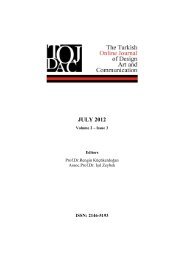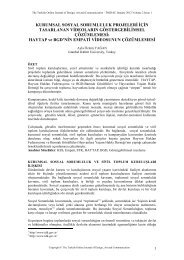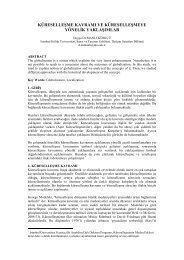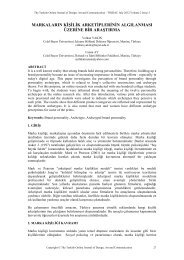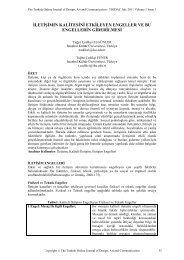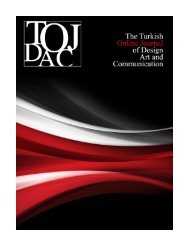aprıl 2012 - tojdac.org
aprıl 2012 - tojdac.org
aprıl 2012 - tojdac.org
You also want an ePaper? Increase the reach of your titles
YUMPU automatically turns print PDFs into web optimized ePapers that Google loves.
The Turkish Online Journal of Design, Art and Communication - TOJDAC April <strong>2012</strong> Volume 2 Issue 2<br />
2. URBAN IDENTITY AND LIGHTENING<br />
The term of identity is commonly used in a number of disciplines concerned with the study of<br />
human behavior, conduct and societal structures in general. Lynch [1] defines identity as “the<br />
extent to which a person can recognize or recall a place as being distinct from other places”.<br />
Like individuals, cities should have character and distinctions; like individuals, this flavour is<br />
made up of numerous characteristics, or identifiable elements [2],[3]. Urban spaces created<br />
through urban design come along as determining and guiding parameters with respect to<br />
urban identity [4]. Cities acquire an identity through the effects of the environment and their<br />
interaction. Especially, historical places are great importance because of reflecting the life<br />
styles of their era in spite of the monotonous view of city’s general structure and because of<br />
having symbolic characteristics of the city so that they provide the region to be known by the<br />
others and present the wealth of beautiful views.<br />
!<br />
Lighting has physical, psychophysical and aesthetic aspects for human perception on urban<br />
identity. A renovated interest about light in the city has grown in the last few years. This due<br />
to a change in life style and way of living public spaces during the night. This interest for<br />
public in general, born in 80’s, was the base for social and architectural studies and for<br />
involving of lighting in urban studies. City lighting was seen more as functional and crime<br />
prevent lighting projects were based on “more lighting equals to more safety”. Starting from<br />
this point of view, a misunderstanding on terms and definitions of outdoor lighting happens<br />
today.<br />
Many cities worldwide are interested in the topic of nighttime urban planning. The purpose is<br />
clearly to enhance citizen safety, security, to support bussiness interests, to save energy and<br />
improve the city’s nighttime ambience, while at the same time minimizening all aspects of<br />
light pollution. When urban centers are being considered the following issues become<br />
important:<br />
• the provision of lighting that will ensure safety from moving vehicles for pedestrians<br />
• the provision of lighting that is appropriate for the type and volume of the vehicular<br />
traffic<br />
• the provision of lighting designs and equipment appropriate to the architectural scene<br />
and urban landscape<br />
• the provision of lighting that will deter anti-social behaviour [5].<br />
Lighting is highly visible and a positive nighttime image of the city can help enhance<br />
communication; social interaction, esthetical enhancing, visual comfort, safety and security.<br />
The goals of a city lightening plan are likely to be [6];<br />
• to establish the city as a leader in sensitivity to its appereance and utility an night as<br />
well as in the day, and to insure recognition of its effective and efficient lighting of<br />
the public and private<br />
• to create a greater sense of the vitality of the city at night, encouraging more frequent<br />
visits by residents and tourists<br />
Urban lighting includes some basic factors in the field of lighting and urban space as;<br />
communication, esthetical enhancing, renewal of outdoor environment, urban renewal. These<br />
factors should be integrated with another one, that is essential. It is the notion of<br />
“environment” as system of relations between subject and his space. It depends on our<br />
sensitivity, it is the result of our perception of space, difference between light and shadow,<br />
colour, of planting, movements and other things.<br />
Urban lighting and public lighting are, in fact, deeply different for the concept itself and for<br />
the way to face a lighting Project. Public lighting is seen more as functional lighting in<br />
outdoor environment, responding to technical parameters, while “urban lighting” is a<br />
Copyright © The Turkish Online Journal of Design, Art and Communication 75



